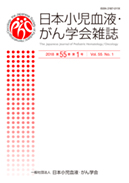Volume 58, Issue 2
Displaying 1-16 of 16 articles from this issue
- |<
- <
- 1
- >
- >|
The 62nd Annual Meeting of the Japanese Society of Pediatric Hematology / Oncology
-
2021Volume 58Issue 2 Pages 89-93
Published: 2021
Released on J-STAGE: August 18, 2021
Download PDF (2735K) -
2021Volume 58Issue 2 Pages 94-98
Published: 2021
Released on J-STAGE: August 18, 2021
Download PDF (772K) -
2021Volume 58Issue 2 Pages 99-102
Published: 2021
Released on J-STAGE: August 18, 2021
Download PDF (4705K)
-
2021Volume 58Issue 2 Pages 103-110
Published: 2021
Released on J-STAGE: August 18, 2021
Download PDF (1020K)
-
2021Volume 58Issue 2 Pages 111-117
Published: 2021
Released on J-STAGE: August 18, 2021
Download PDF (1082K)
-
2021Volume 58Issue 2 Pages 118-123
Published: 2021
Released on J-STAGE: August 18, 2021
Download PDF (2814K)
Review Article
-
2021Volume 58Issue 2 Pages 124-131
Published: 2021
Released on J-STAGE: August 18, 2021
Download PDF (1478K)
Original Article
-
2021Volume 58Issue 2 Pages 132-137
Published: 2021
Released on J-STAGE: August 18, 2021
Download PDF (1188K) -
2021Volume 58Issue 2 Pages 138-148
Published: 2021
Released on J-STAGE: August 18, 2021
Download PDF (1089K) -
2021Volume 58Issue 2 Pages 149-155
Published: 2021
Released on J-STAGE: August 18, 2021
Download PDF (863K)
Case Report
-
2021Volume 58Issue 2 Pages 156-159
Published: 2021
Released on J-STAGE: August 18, 2021
Download PDF (1190K) -
2021Volume 58Issue 2 Pages 160-165
Published: 2021
Released on J-STAGE: August 18, 2021
Download PDF (1069K) -
2021Volume 58Issue 2 Pages 166-170
Published: 2021
Released on J-STAGE: August 18, 2021
Download PDF (3497K) -
2021Volume 58Issue 2 Pages 171-174
Published: 2021
Released on J-STAGE: August 18, 2021
Download PDF (2669K)
Report of Committee
-
2021Volume 58Issue 2 Pages 175-181
Published: 2021
Released on J-STAGE: August 18, 2021
Download PDF (1677K)
Report
-
2021Volume 58Issue 2 Pages 182-183
Published: 2021
Released on J-STAGE: August 18, 2021
Download PDF (659K)
- |<
- <
- 1
- >
- >|
